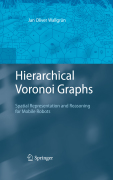
Hierarchical Voronoi graphs: spatial representation and reasoning for mobile robots
Oliver Wallgrün, Jan
Voronoi graphs and their hierarchical extensions have become a widely used tool for deriving abstract spatial representations from environmental data. Theyare currently being studied and applied in several subfields of computer science such as AI and robotics, computational geometry, and geoinformatics. This book investigates the application of hierarchical Voronoi graphs for the internal spatial memory of a mobile robot, focusing on the robot mapping problem ofderiving the correct representation from uncertain data. The author develops and illustrates several fundamental techniques for constructing hierarchical Voronoi graph representations, employing a broad set of methods ranging from spatial abstraction approaches to graph matching, search, and qualitative spatial reasoning. It is further shown how the developed tools can be combined to form an overall robot mapping system. The presented material is intended for researchers, students, and practitioners with backgrounds in robotics, AI, or related fields who are engaged with spatial representations and reasoning. The author focuses on a particular kind of topological representation of space, the hierarchical annotated generalized Voronoi graph INDICE: Introduction.- Robot Mapping.- Voronoi-Based Spatial Representations.- Simplification and Hierarchical Voronoi Graph Construction.- Voronoi Graph Matching for Data Association.- Global Mapping: Minimal Route Graph Models Under Spatial Constraints.- Experimental Evaluation.- Conclusions and Outlook.-App. A, Mapping as Probabilistic State Estimation.- App. B, Qualitative Spatial Reasoning.- References.
- ISBN: 978-3-642-10302-5
- Editorial: Springer
- Encuadernacion: Cartoné
- Páginas: 218
- Fecha Publicación: 25/12/2009
- Nº Volúmenes: 1
- Idioma: Inglés
